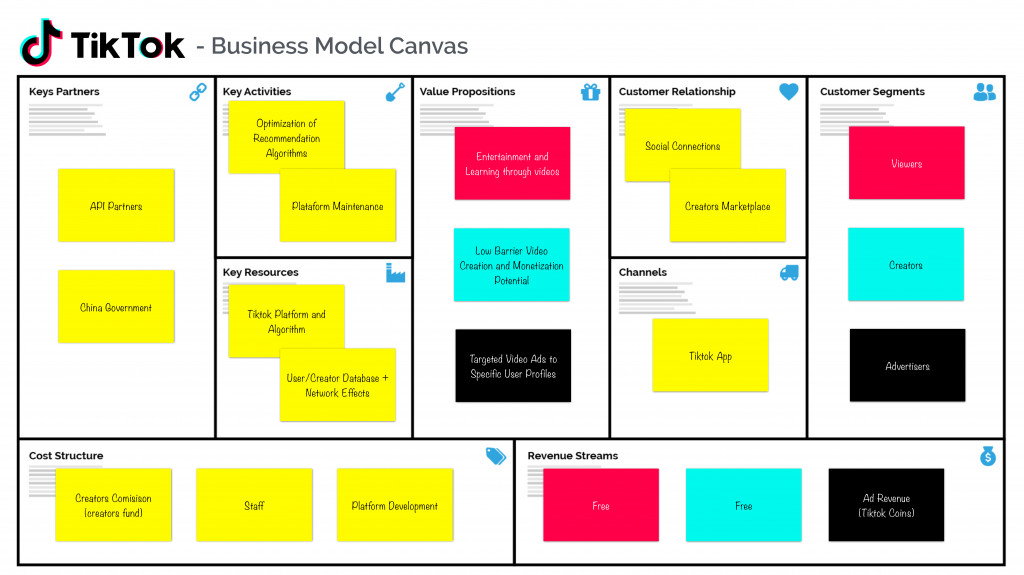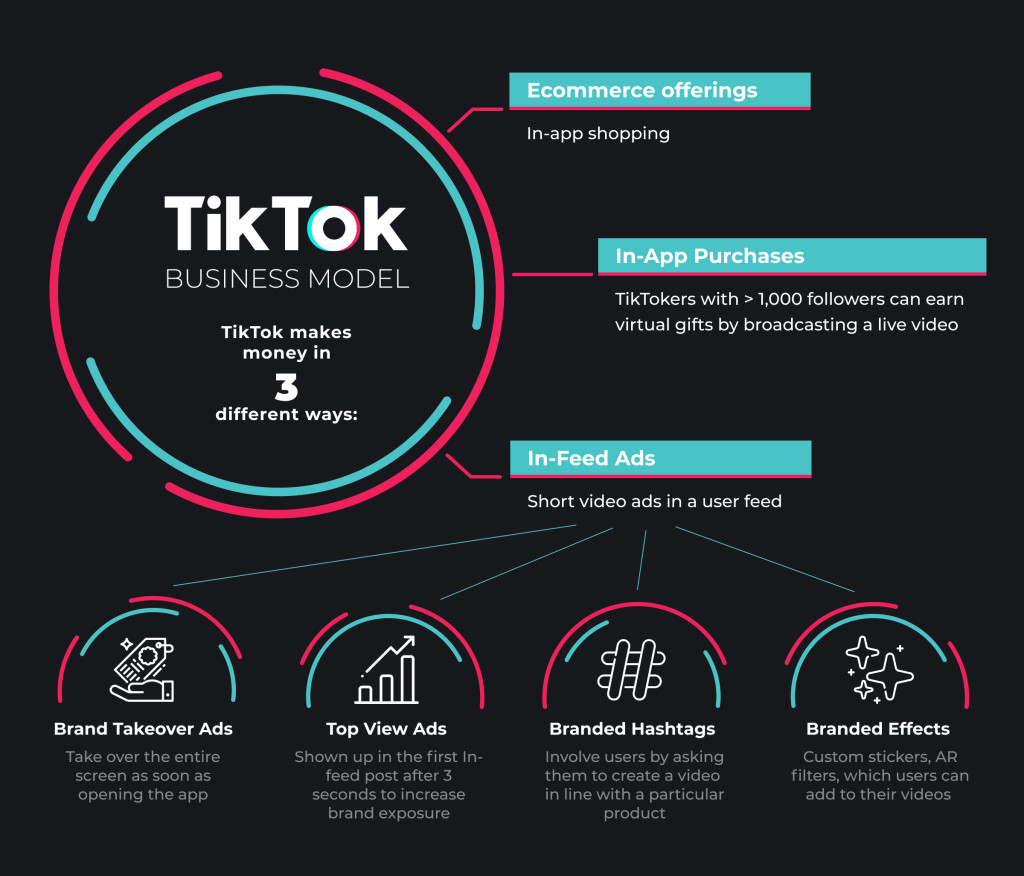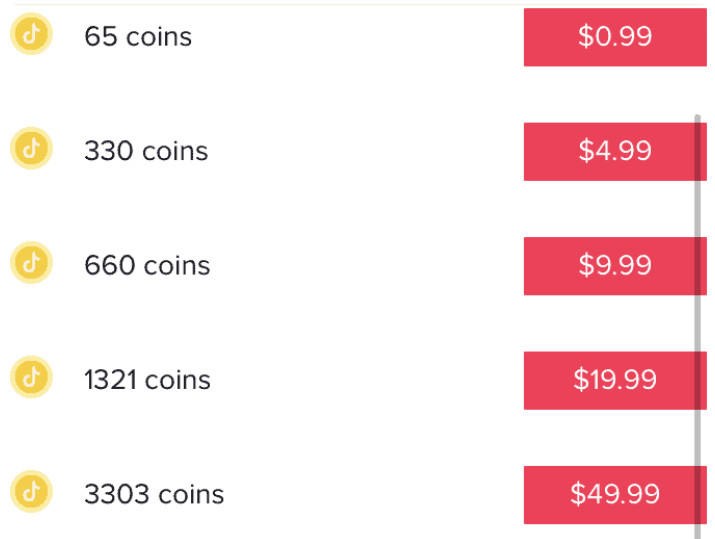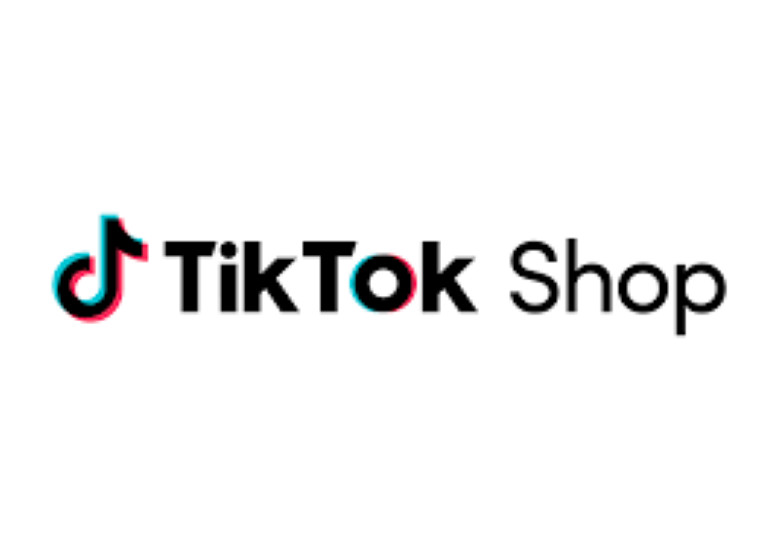How does TikTok make money? TikTok, beyond its viral dances and trending challenges, is a financial powerhouse, and money-central.com is here to break down exactly how it generates revenue. Let’s explore the diverse income streams that fuel this short-form video giant, offering a clear picture of its financial strategy and paving your way to improve your financial literacy. Learn about advertising revenue, in-app purchases, and innovative eCommerce offerings driving TikTok’s impressive financial growth.
1. Understanding TikTok’s Multifaceted Business Model
TikTok’s business model is a dynamic blend of several revenue streams, each contributing to its impressive financial performance. The key components are the advertising-based model, digital goods model, and commission-based model. Let’s take a closer look at each one to understand how they work together to generate revenue for TikTok.
 TikTok Business Model
TikTok Business Model
1.1. What is the Advertising-Based Business Model?
TikTok’s advertising-based business model is one of its primary revenue drivers. This model involves selling ad space to businesses and marketplaces, allowing them to promote their products and services to TikTok’s vast user base. In 2023, advertising revenue reached $13.2 billion, demonstrating the effectiveness of this strategy. According to research from New York University’s Stern School of Business, advertising accounts for approximately 70% of TikTok’s overall revenue, underscoring its significance. TikTok offers a variety of ad formats, including in-feed ads, top view ads, branded hashtags, and branded effects. These diverse options enable businesses to tailor their advertising approach to best suit their needs and target audience.
1.2. How Does the Digital Goods Business Model Work?
The digital goods business model revolves around the sale of virtual items within the app. TikTok introduced its virtual currency, TikTok Coins, which users can purchase with real money. These coins can then be used to send virtual gifts to content creators as a token of appreciation. For instance, 100 TikTok Coins can be acquired for 99 cents. This system not only provides users with a way to support their favorite creators but also generates revenue for TikTok. The appeal of this model lies in its low-risk nature and the enjoyment users derive from engaging with digital goods.
1.3. What is the Commission-Based Business Model?
The commission-based business model involves TikTok taking a percentage of the revenue generated through in-app transactions. When a user buys coins and virtually donates them to a content creator, the creator can withdraw these tips for real money. TikTok takes a 50% share of every dollar withdrawn, creating a significant revenue stream for the platform. This model aligns the interests of TikTok and its content creators, incentivizing both to create engaging content and drive user engagement.
2. Exploring TikTok’s Key Revenue Sources
What are the main sources of income for TikTok? TikTok generates revenue through three primary channels: advertising, in-app purchases, and eCommerce offerings. Understanding each of these sources provides a comprehensive view of TikTok’s financial strategy.
 How does TikTok make money
How does TikTok make money
2.1. How Does TikTok Advertising Generate Revenue?
Advertising on TikTok is a major revenue stream, offering a variety of ad formats to businesses and brands. These formats include in-feed ads, brand takeover ads, top view ads, branded hashtag ads, and branded effect ads. Advertisers pay based on metrics like impressions, clicks, and engagement, making it a lucrative channel for TikTok.
2.1.1. What are In-Feed Ads?
In-feed ads are designed to blend seamlessly into the user’s feed, similar to ads on Instagram. They appear as users scroll through videos, making them a non-intrusive way to promote products or services.
2.1.2. What are Brand Takeover Ads?
Brand takeover ads appear immediately when the app is opened, taking over the full screen. These ads are designed to boost brand recognition and deliver instant messages to users.
2.1.3. What are Top View Ads?
Top view ads show up after users scroll for a short period. Like brand takeover ads, they take up the entire screen, auto-play, and can run for up to 60 seconds, providing an extended opportunity to engage with the audience.
2.1.4. What are Branded Hashtag Ads?
Branded hashtag ads leverage TikTok’s popular challenges and trends, turning them into a revenue stream. Creators are invited to make videos featuring specific hashtags or brands, which is both fun for users and effective for brand promotion.
2.1.5. What are Branded Effect Ads?
Branded effect ads utilize TikTok’s signature video effects, including custom stickers, AR filters, and lenses. Users can create videos with these effects, promoting the brand within a limited time frame of 10 days.
2.2. How Do In-App Purchases Contribute to TikTok’s Revenue?
How do in-app purchases work? Before the introduction of TikTok for Business, in-app purchases, specifically TikTok Coins, were a primary source of revenue. Creators with at least 1,000 followers can earn virtual gifts from their fans by broadcasting live videos.
 TikTok Coins
TikTok Coins
2.2.1. How Do TikTok Coins Work?
TikTok Coins are a virtual currency that fans can use to tip their favorite content providers. Fans can purchase these coins with real money and then use them to send presents to creators. This system not only assists TikTok in generating revenue but also provides TikTokers with a way to monetize their content.
2.3. What Role Do eCommerce Offerings Play in TikTok’s Revenue?
How does TikTok generate revenue through eCommerce? TikTok makes money through its eCommerce offerings by allowing businesses to sell products directly within the app. This is facilitated through features like TikTok Shop and shoppable ads. These tools enable brands to create a seamless shopping experience for users, where they can browse and purchase items without leaving the platform. TikTok earns revenue by taking a commission from each sale made through its eCommerce features.
2.3.1. What is TikTok Shop?
TikTok Shop is a feature that allows brands to sell products directly on the platform. Initially, it was intended to assist small enterprises that had not yet established brick-and-mortar stores due to high investment expenses. However, its increasing popularity has attracted both small businesses and big brands.
 TikTok Shop
TikTok Shop
2.3.2. How Can Brands Sell on TikTok Shop?
Brands can sell on TikTok Shop in two primary ways:
- Directly promote and sell their products: This involves using live streaming or short videos with product links integrated within the posts. When a customer clicks on the product, they are directed to the product detail page. Brands are responsible for generating and publishing their own content under this option.
- Through the TikTok Affiliate program: Brands can engage in the affiliate program, building promotion programs and encouraging TikTok content creators to promote their products for a fee. This service makes it easier for influencers to earn commission on sales that they enable.
2.3.3. What are the Fees Associated with TikTok Shop?
As of 2024, the transaction fee for most regions, including countries like Malaysia, is around 3.78% of the total order value, including shipping. Additionally, TikTok Shop charges a commission fee, which ranges from 2% to 8% based on factors like the seller’s sales volume and product category. These fees contribute significantly to TikTok’s overall revenue from its eCommerce activities.
3. Factors Impacting TikTok’s Revenue
What factors influence TikTok’s financial performance? Despite its rapid growth, several factors have affected TikTok’s revenue growth. Key challenges include increased regulatory scrutiny, funding platform discounts, heavy investments in eCommerce, and rising operational costs.
3.1. How Does Regulatory Scrutiny Affect TikTok’s Revenue?
Increased regulatory scrutiny, especially in countries like the U.S. and India, has significantly impacted TikTok’s revenue. Restrictions and bans due to concerns over data privacy and national security have reduced TikTok’s ability to fully monetize its global user base. These geopolitical tensions have forced TikTok to navigate complex legal landscapes, affecting its market reach and revenue potential.
3.2. What is the Impact of Funding Platform Discounts and eCommerce Investments?
TikTok’s shift toward funding platform discounts and heavy investments in eCommerce to compete with giants like Amazon and Instagram has strained its profitability. These discounts, meant to attract more sellers and users, eat into potential ad revenue and commission earnings. While these strategies aim to enhance long-term growth, they pose short-term challenges to TikTok’s financial performance.
3.3. How Do Rising Operational Costs Influence TikTok’s Profitability?
Rising operational costs associated with expanding into new markets and maintaining a global infrastructure have further squeezed TikTok’s profits. These costs include expenses related to data storage, content moderation, and technological development. As TikTok continues to grow, managing these operational costs effectively is crucial for sustaining its profitability.
4. TikTok’s Future Outlook: Growth and Opportunities
What does the future hold for TikTok? Looking ahead, TikTok’s gross merchandise volume (GMV) is projected to reach $23 billion, driven by its increasing integration of shopping features and partnerships with brands. The introduction of TikTok For Business and TikTok Shop presents significant opportunities for businesses to engage with customers directly on the platform.
4.1. What Opportunities Does TikTok For Business Offer?
TikTok For Business enables brands to showcase and sell their products directly on the platform without redirecting users to external sites. This presents a significant opportunity for businesses to leverage TikTok’s broad appeal across all age groups and engage with customers in innovative ways.
4.2. How Can Businesses Capitalize on TikTok’s Growth?
With TikTok’s broad appeal across all age groups, brands have more opportunities than ever to engage with customers. If you’re considering joining TikTok, now is the perfect time to seize the opportunity and ride the wave of this growing trend. By creating engaging content and utilizing TikTok’s various advertising and eCommerce features, businesses can effectively reach their target audience and drive sales.
5. TikTok’s Revenue Streams: A Detailed Breakdown
How does TikTok actually make its money? Let’s break down TikTok’s key revenue streams into a detailed table for a clearer understanding.
| Revenue Stream | Description | Key Features | Contribution to Revenue |
|---|---|---|---|
| Advertising | Selling ad space to businesses for promotion. | In-feed ads, brand takeover ads, top view ads, branded hashtag ads, branded effect ads. | High |
| In-App Purchases | Selling virtual currency (TikTok Coins) for users to send gifts to content creators. | Users buy coins with real money, then gift them to creators. | Medium |
| eCommerce Offerings | Allowing businesses to sell products directly within the app through TikTok Shop and shoppable ads. | Direct sales through live streaming and short videos, affiliate programs. | Medium |
| Transaction Fees | Charging a percentage of the total order value for transactions made through TikTok Shop. | Typically around 3.78% of the total order value, including shipping. | Significant |
| Commission Fees | Taking a commission on sales made through TikTok Shop. | Ranges from 2% to 8% based on seller’s sales volume and product category. | Significant |
| Data Monetization | Aggregating user data and selling anonymized insights to advertisers and businesses for targeted advertising. | Data includes user demographics, interests, and behavior. | Medium |
| Partnerships & Licensing | Collaborating with other companies for co-branded content and licensing TikTok’s technology. | Partnerships with media companies, music labels, and other content platforms. | Low |
| Subscription Services | Offering premium features or content to users through subscription models. | Ad-free experiences, exclusive content, and advanced editing tools. | Low |
| Live Streaming Gifts | Allowing viewers to send virtual gifts to creators during live streams. | Virtual gifts purchased with TikTok Coins. | Medium |
| Educational Programs | Offering educational content and workshops to users and creators on various topics, including content creation, marketing, and business skills. | Workshops, courses, and tutorials led by industry experts. | Low |
| Branded Merchandise | Selling branded merchandise, such as clothing, accessories, and collectibles, through TikTok Shop. | Partnerships with brands and creators to produce exclusive merchandise. | Low |
| Music Licensing Fees | Charging fees to businesses that use licensed music in their TikTok videos. | Partnerships with music labels and artists to provide access to a vast music library. | Medium |
| Event Sponsorships | Sponsoring live events and concerts, both online and offline, to promote the TikTok brand and engage with users. | Partnerships with event organizers to create branded experiences. | Low |
| User-Generated Content | Leveraging user-generated content for promotional purposes and advertising campaigns, often compensating creators for their contributions. | Content creation challenges, contests, and collaborations with influencers. | Medium |
| Advertising Tech | Developing and licensing advertising technology to other platforms and businesses. | AI-powered ad targeting, creative ad formats, and analytics tools. | Low |
| Enterprise Solutions | Providing customized solutions and services to enterprise clients, such as branding, marketing, and advertising support. | Tailored campaigns, data analytics, and content creation services. | Low |
| Global Expansion | Expanding into new markets and regions, increasing the user base and potential revenue streams. | Localization of content and services, partnerships with local businesses, and targeted marketing campaigns. | High |
| Data Analytics | Providing data analytics and insights to businesses and advertisers to help them optimize their campaigns and understand their target audience. | Detailed reports, dashboards, and data visualization tools. | Medium |
| Influencer Marketing | Facilitating partnerships between influencers and brands, earning a commission on influencer marketing campaigns. | Influencer discovery platforms, campaign management tools, and performance tracking. | Medium |
| Virtual Events | Hosting virtual events, such as concerts, conferences, and workshops, and charging users for access. | Live streaming, interactive sessions, and virtual networking opportunities. | Low |
| AR/VR Experiences | Developing and monetizing augmented reality (AR) and virtual reality (VR) experiences on the platform. | Branded filters, virtual try-on experiences, and interactive AR games. | Low |
| Donations | Partnering with charities and non-profit organizations to facilitate donations through the platform. | Donation stickers, donation campaigns, and matching programs. | Low |
| Gaming Integration | Integrating gaming features and partnerships with game developers to create new revenue streams. | In-app games, branded gaming experiences, and cross-promotion opportunities. | Low |
| NFT Marketplace | Launching a non-fungible token (NFT) marketplace where creators can sell their digital artwork and collectibles. | NFT creation tools, auction platforms, and community features. | Low |
| Premium Content | Offering exclusive content and features to users who subscribe to premium services. | Ad-free experiences, bonus features, and access to exclusive content. | Low |
| Cloud Services | Providing cloud-based services for content creators, such as storage, editing, and collaboration tools. | Scalable storage, advanced editing features, and real-time collaboration tools. | Low |
| Global Commerce | Facilitating cross-border transactions and expanding e-commerce offerings to new markets. | Multi-currency support, localized payment options, and international shipping solutions. | High |
| AI-Powered Services | Leveraging artificial intelligence (AI) to enhance user experiences, personalize content recommendations, and improve ad targeting. | AI-powered content moderation, personalized recommendations, and automated ad optimization. | Medium |
| Subscription Bundles | Offering bundled subscription services that include access to multiple apps and platforms. | Combined subscriptions with other apps and platforms, such as music streaming services and productivity tools. | Low |
| Blockchain Integration | Integrating blockchain technology to improve transparency, security, and traceability of transactions. | Secure payment processing, digital identity verification, and content ownership verification. | Low |
| Extended Reality (XR) | Developing extended reality (XR) experiences that combine augmented reality (AR) and virtual reality (VR) technologies. | Interactive AR filters, virtual try-on experiences, and immersive VR games. | Low |
| Metaverse Integration | Integrating TikTok with metaverse platforms to create immersive experiences and virtual events. | Virtual concerts, metaverse meetups, and interactive brand experiences. | Low |
This table provides a comprehensive view of how TikTok leverages various revenue streams to generate its substantial income.
6. Common Questions About TikTok’s Revenue Model
6.1. How Much Revenue Does TikTok Generate Annually?
TikTok’s annual revenue varies, but in 2023, it generated approximately $13.2 billion from advertising alone. This figure highlights the platform’s significant financial success and its growing influence in the digital advertising market.
6.2. What Percentage of TikTok’s Revenue Comes from Advertising?
Advertising accounts for a significant portion of TikTok’s revenue, estimated to be around 70%. This underscores the importance of advertising as a primary revenue driver for the platform.
6.3. How Do TikTok Coins Work and Contribute to Revenue?
TikTok Coins are a virtual currency that users purchase with real money to send virtual gifts to content creators. TikTok takes a portion of the revenue generated from these transactions, making it a valuable source of income.
6.4. What is TikTok Shop and How Does It Generate Revenue?
TikTok Shop allows businesses to sell products directly on the platform. TikTok earns revenue by taking a commission from each sale made through this feature, making it a significant contributor to the platform’s overall revenue.
6.5. How Does TikTok’s Affiliate Program Work?
TikTok’s affiliate program allows brands to partner with content creators, who promote their products for a fee. This program enables influencers to earn commission on sales they enable, contributing to TikTok’s overall revenue through affiliate marketing.
6.6. What Factors Have Affected TikTok’s Revenue Growth?
Several factors have affected TikTok’s revenue growth, including increased regulatory scrutiny, funding platform discounts, heavy investments in eCommerce, and rising operational costs.
6.7. What is the Future Outlook for TikTok’s Revenue?
Looking ahead, TikTok’s gross merchandise volume (GMV) is projected to reach $23 billion, driven by its increasing integration of shopping features and partnerships with brands. This positive outlook suggests continued growth and financial success for the platform.
6.8. How Can Businesses Benefit from Advertising on TikTok?
Businesses can benefit from advertising on TikTok by reaching a broad audience, engaging with customers in creative ways, and driving sales through various ad formats and eCommerce features.
6.9. How Does TikTok Ensure Data Privacy and Security for Its Users?
TikTok has implemented various measures to ensure data privacy and security for its users, including data encryption, content moderation, and compliance with privacy regulations.
6.10. How Can Content Creators Monetize Their Content on TikTok?
Content creators can monetize their content on TikTok through various methods, including earning virtual gifts from fans, participating in affiliate programs, and partnering with brands for sponsored content.
7. Conclusion: Navigating the World of TikTok Finances
Understanding how TikTok makes money involves examining its diverse revenue streams, from advertising and in-app purchases to eCommerce and affiliate marketing. Despite facing challenges such as regulatory scrutiny and rising operational costs, TikTok’s future outlook remains positive, with significant opportunities for growth and financial success. This comprehensive overview provides valuable insights into the financial strategies that drive one of the world’s most popular social media platforms. To further enhance your financial literacy and explore more opportunities, visit money-central.com for more in-depth articles, tools, and expert advice. Ready to take control of your financial future? Explore money-central.com today and unlock a wealth of resources to help you achieve your financial goals.
For more information, you can reach us at:
- Address: 44 West Fourth Street, New York, NY 10012, United States
- Phone: +1 (212) 998-0000
- Website: money-central.com